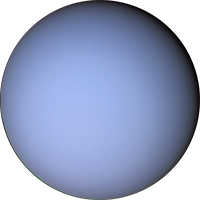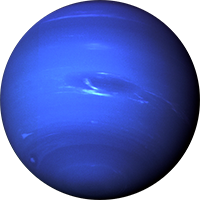The Outer Planets
The four outer planets, or gas giants (sometimes called Jovian planets), collectively make up 99% of the mass known to orbit the Sun. Jupiter and Saturn are each many tens of times the mass of Earth and consist overwhelmingly of hydrogen and helium; Uranus and Neptune are far less massive (<20 Earth masses) and possess more ices in their makeup. For these reasons, some astronomers suggest they belong in their own category, "ice giants". All four gas giants have rings, although only Saturn's ring system is easily observed from Earth. The term superior planet designates planets outside Earth's orbit and thus includes both the outer planets and Mars.
Jupiter

Jupiter is the most massive planet in our solar system; with four large moons and many smaller moons it forms a kind of miniature solar system. In fact, Jupiter resembles a star in composition, and if it had been about 80 times more massive, it would have become a star rather than a planet.
On 7 January 1610, using his primitive telescope, astronomer Galileo Galilei saw four small "stars" near Jupiter. He had discovered Jupiter's four largest moons, now called Io, Europa, Ganymede, and Callisto. These four moons are known today as the Galilean satellites.
Newly discovered moons of Jupiter are reported by astronomers and acknowledged with a temporary designation by the International Astronomical Union; once their orbits are confirmed, they are included in Jupiter's large moon count. Not including the "temporary" moons, Jupiter has 50 total.
Saturn

Saturn was the most distant of the five planets known to the ancients. In 1610, Italian astronomer Galileo Galilei was the first to gaze at Saturn through a telescope. To his surprise, he saw a pair of objects on either side of the planet. He sketched them as separate spheres, thinking that Saturn was triple-bodied. Continuing his observations over the next few years, Galileo drew the lateral bodies as arms or handles attached to Saturn. In 1659, Dutch astronomer Christiaan Huygens, using a more powerful telescope than Galileo's, proposed that Saturn was surrounded by a thin, flat ring. In 1675, Italian-born astronomer Jean-Dominique Cassini discovered a division between what are now called the A and B rings. It is now known that the gravitational influence of Saturn's moon Mimas is responsible for the Cassini Division, which is 4,800 km (3,000 miles) wide.
Like Jupiter, Saturn is made mostly of hydrogen and helium. Its volume is 755 times greater than that of Earth. Winds in the upper atmosphere reach 500 m (1,600 feet) per second in the equatorial region. (In contrast, the strongest hurricane-force winds on Earth top out at about 110 m, or 360 feet per second.) These super-fast winds, combined with heat rising from within the planet's interior, cause the yellow and gold bands visible in the atmosphere.
Uranus

Uranus, discovered in 1781 by astronomer William Herschel, was the first planet found with the aid of a telescope. As the seventh planet from the sun, Uranus takes 84 Earth years to complete one orbit.
Like Venus, Uranus rotates east to west. Uranus' rotation axis is tilted almost parallel to its orbital plane, so Uranus appears to be rotating on its side. This situation may be the result of a collision with a planet-sized body early in the planet's history, which apparently radically changed Uranus' rotation. Because of Uranus' unusual orientation, the planet experiences extreme variations in sunlight during each 20-year-long season.
Voyager 2, the only spacecraft to visit Uranus, imaged a bland-looking sphere in 1986. When Voyager flew by, the south pole of Uranus pointed almost directly at the sun because Uranus was near its southern summer solstice, with the southern hemisphere bathed in continuous sunlight and the northern hemisphere radiating heat into the blackness of space.
Neptune

The ice giant Neptune was the first planet located through mathematical predictions rather than through regular observations of the sky. (Galileo had recorded it as a fixed star during observations with his small telescope in 1612 and 1613.) When Uranus didn't travel exactly as astronomers expected it to, a French mathematician, Urbain Joseph Le Verrier, proposed the position and mass of another as yet unknown planet that could cause the observed changes to Uranus' orbit.
After being ignored by French astronomers, Le Verrier sent his predictions to Johann Gottfried Galle at the Berlin Observatory. Galle found Neptune on his first night of searching in 1846. Seventeen days later, its largest moon, Triton, was also discovered.
Nearly 4.5 billion km (2.8 billion miles) from the sun, Neptune orbits the sun once every 165 years. It is invisible to the naked eye because of its extreme distance from Earth. Interestingly, the unusual elliptical orbit of the dwarf planet Pluto brings Pluto inside Neptune's orbit for a 20-year period out of every 248 Earth years. Pluto can never crash into Neptune, though, because for every three laps Neptune takes around the sun, Pluto makes two. This repeating pattern prevents close approaches of the two bodies.





